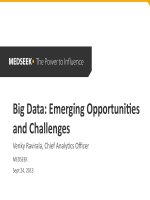Retail banks and big data
Bạn đang xem bản rút gọn của tài liệu. Xem và tải ngay bản đầy đủ của tài liệu tại đây (384.43 KB, 11 trang )
A report from the Economist Intelligence Unit
Retail banks and big data:
Big data as the
key to better risk
management
Retail banks and big data: Risk and compliance executives weigh in
Big data as the key to better risk management
Big data as the key to better risk
management
The business of banking depends on evaluating risks
and then acting on those insights. In theory, more
information should yield better risk assessments,
which is why big data and its associated tools
couldn’t have arrived at a better time.
The ability to harness larger and more diverse
data pools in support of business decision-makers
holds the promise of both reducing losses by
managing risks and increasing revenue by
highlighting business opportunities. Successfully
managing risks today requires that bankers
identify, access and analyse trusted data and share
their results across the bank.
The growth of risk
As recent headlines bear out, risks increase with
complexity, and complexity has grown across every
dimension of the banking industry. Banking has
become more concentrated, which means that a
handful of giant institutions must coordinate a
diverse array of products, processes, technologies,
organisational structures and legal contracts.
Financial innovation leads to new instruments and
specialties. Markets are more interconnected and
1
© The Economist Intelligence Unit Limited 2014
information traverses those connections more
rapidly. As a result, when things go wrong,
volatility can switch markets from tranquil to
turbulent almost instantly, leading to “volatility
clustering” that can result in liquidity crises like
those seen in the 2007-2009 financial crisis or the
2001 bursting of the dotcom bubble.
Clearly, the landscape of banking risks is vast.
“We have identified 13 different types of systemic
risk: cyber-risk; high-frequency trading risk;
counterparty risk; collateral risk; liquidity risk; and
the list goes on,” says Mike Leibrock, vicepresident of systemic risk at the Depository Trust
Clearing Corporation (DTCC), which provides
clearing and settlement services to large banks.
“And there is an entire category of
interconnectedness risks, which arise from linkages
among a handful of key banks for clearance and
settlement activities.”
As regulators—and therefore also the
institutions that they regulate—focus as never
before on identifying, measuring, and managing
emerging risks across the financial system, data
management practices are also changing.
Retail banks and big data: Risk and compliance executives weigh in
Big data as the key to better risk management
Regional breakdown of survey respondents
% of all respondents
25
25
North America
Asia-Pacific
24
Western Europe
10
Latin America
8
Middle East
7
Africa
Eastern Europe
2
Source: Economist Intelligence Unit survey, July, 2014.
The promise and potential of big
data
Banks are experts in manipulating the rows and
columns of numbers captured from past
transactions and stored in vast data warehouses.
On a daily or even intra-day basis, banks package
these facts in the form of reports for credit or
finance officers to review for trends and outliers.
Big data is different. It is vast in scope, varied in
form and instantaneous in velocity, encompassing
data from mobile devices, social media applications
and website visits as well as information from
third-party providers of credit, spending, auto and
legal data. It promises to reveal hidden consumer
behaviors that may not be immediately apparent
even to those with highly sophisticated knowledge
and experience. Big data potentially allows banks
to measure and manage risk at an individual
customer level, as well as at a product or portfolio
level, and to be much more precise in credit
approvals and pricing decisions.
To learn more about the intersection between
big data and risk management at banks, the
Economist Intelligence Unit (EIU) surveyed 208
risk management and compliance executives at
retail banks (29%), commercial banks (43%) and
investment banks (28%) in 55 countries on six
continents. The results demonstrate that growing
numbers of bankers are embracing the analysis and
sharing of big data, but that they still face
challenges in applying the results to delivering
superior risk management performance—especially
around liquidity and credit risk.
2
© The Economist Intelligence Unit Limited 2014
The survey asked executives to rate their own
institution’s performance in controlling and
mitigating risk. Those that rated their institution
above average were also more likely to use:
l basic big data tools to integrate, manipulate
and access structured and unstructured data
(35% for the above-average risk managers
versus 7% of those rated average or below)
l more advanced big data tools such as predictive
analytics and visualisation (33% versus 8%).
In other words, banks that perform better are
more likely to use a variety of different
methodologies, including both basic and advanced
analytics, to understand and manage their risks.
Moreover, they’re more likely to bring large
amounts of data to bear on risk management
problems.
Investments in big data to support
risk management
In addition to the four regions, survey respondents
came from three types of institutions: 43% from
commercial banks and the rest divided evenly
between retail and investment banks. All three are
more concerned about liquidity and credit risk than
other types of risk. At the same time, the
importance they assign to different types of risk
varies by industry and region.
l Retail banks are more concerned about credit
risk (53% versus 43% among commercial and
investment banks).
l The commercial banks tend to be slightly more
concerned about market risk (28% versus 23%
among investment and retail banks).
Retail banks and big data: Risk and compliance executives weigh in
Big data as the key to better risk management
In which risk areas will your organisation face the greatest challenges in the next three years?
% of all respondents
44
45
Liquidity risk
40
41
40
Credit risk
33
33
Foreign investment risk
26
Market risk
17
31
21
23
Operational risk
25
11
Compliance risk
54
8
Which of the following risk
management techniques/tools
is your organization currently
using and which do you expect
it to be using in three years?
58
58
37
33
Africa, Latin America, Middle East
Asia-Pacific
North America
Europe
29
15
15
25
Source: Economist Intelligence Unit survey, July, 2014.
81
% of all respondents
Comprehensive information on the
organisation’s overall risk profile
routinely provided to the Board and
senior executives
15
Using now
Source: Economist Intelligence Unit survey, July, 2014.
l Investment banks, meanwhile, tend to be more
concerned about operational (29% versus 19%)
and compliance risk (20% versus 14%).
From a regional perspective, Asia-Pacific and the
emerging markets have heightened concern about
exposure to market risk, while Europe has elevated
concerns about both liquidity and credit risk.
Across all regions and industry sectors, the vast
majority of banks already support risk management
by investing in big data or expect to do so soon.
Four out of five (81%) routinely provide
comprehensive reports on the bank’s risk profile to
senior executives, and another 15% plan to do so
in the next three years. Almost all are committed to
3
© The Economist Intelligence Unit Limited 2014
Likely to be using
in 3 years
3
No plans for using
in 3 years
pushing risk management information up to top
decision-makers.
“The types of things that are most commonly
requested are the Volcker metric-related variables
that show our liquidity, balances, risk ratios and
exposures,” says Wells Fargo Chief Data Officer
Charles Thomas.
But the question remains: Do they have access
to the right big data tools to do so and to be truly
effective?
Just over four out of ten (42%) respondents
currently have the ability to integrate, manipulate
and query big data when creating risk profiles.
Almost half (47%) have plans to invest in these
Retail banks and big data: Risk and compliance executives weigh in
Big data as the key to better risk management
What is your organisation using now and what do you expect in three years?
% of all respondents
Now
Comprehensive data on the organisation’s risk profile
routinely provided to the board and senior executives
In 3 years
81
Basic big data tools to integrate, manipulate and
access structured and unstructured data
15
42
Advanced big data tools such as predictive
analytics and data visualization
47
41
44
Source: Economist Intelligence Unit survey, July, 2014.
tools over the next three years.
The proportions are slightly lower for advanced
big data tools, such as predictive analytics and
data visualisation: 41% use them now and 44%
expect to obtain them during the next three years.
Still, an overwhelming majority of banks—retail,
commercial, investment, from every continent—is
committed to and leveraging the power of big data.
Tackling the two greatest risks:
credit and liquidity
The bankers surveyed believe that, over the next
three years, liquidity and credit risk will pose the
greatest challenges for their institutions. They also
say these two areas of risk reflect the greatest
potential for big data and its associated tools to
make an impact on improving risk management.
Why the intense focus on credit and liquidity
risk? Banks are in the business of selling liquidity.
Pursuing profits necessarily thins capitalization
and leaves little margin for error. “The common
feature of the financial services industry—banks,
brokerage firms, hedge funds—is that there is a
small amount of equity and a large amount of
financing supporting the firm’s assets,” says Robert
Chersi, former CFO of Fidelity Investments and now
a professor of finance at Pace University in New
York. “Financial services firms rely on other people
to finance them, and most of that financing is
short-term. It can disappear in an instant.”
Credit and liquidity risk represent two faces of
the same phenomenon. Banks borrow via shortterm instruments in order to finance the longerterm instruments that they sell to their customers.
That leverage can be lost quickly as funding is
withdrawn. At best the bank is left without
products to sell; at worst, as occurred with Lehman
and Barings, the liquidity whipsaw can destroy the
bank—but this kind of disaster scenario is typically
preceded by expectations that the bank’s creditors
will default.
The problem with forecasting liquidity crises to
date is that liquidity risk has been difficult to
model. “It’s a risk that only materialises in extreme
situations and is very much a binary risk,” says
Michael O’Connell, a managing director at Aon Risk
Solutions. But according to survey respondents,
the use of big data offers the promise of linking
seemingly unconnected external events in real
time—events that could presumably precede a
In which risk areas will your organisation face the greatest challenges in the next three years?
% of all respondents
50
Liquidity risk
45
Credit risk
32
Foreign investment risk
25
Market risk
22
Operational risk
Compliance risk
4
© The Economist Intelligence Unit Limited 2014
16
Source: Economist Intelligence Unit survey, July, 2014.
Retail banks and big data: Risk and compliance executives weigh in
Big data as the key to better risk management
Equity as a percent of total capitalisation for selected industries
%
Internet software and services
Computer software
Household products
Computer services
Integrated oil and gas
Healthcare services
Farms and agriculture
Retail
Transportation
Telecom services
Utilities
Banks
Brokerages
All financial services
96
92
88
85
77
77
69
69
60
60
51
25
24
16
Source: S&P/Capital IQ.
Which of the following areas presents the biggest opportunities for Big Data to improve
performance in meeting liquidity requirements?
% of all respondents
Ability to interpret seemingly
unconnected external events in real time
46
Improved accuracy of
capital cost scenarios
44
Automated production of
compliance data and reports
38
Source: Economist Intelligence Unit survey, July, 2014.
liquidity crisis such as rising credit spreads or a
flight to quality. Running a close second was the
ability to predict the amount and cost of capital
required in stressful market situations.
Fraud applications
A large sample can reveal rare events that don’t
show up in small data sets. When events occur
infrequently—credit card fraud, for instance,
occurs in perhaps five out of every 1,000
transactions—millions of transactions become
necessary to generate a usefully large sample of
fraudulent ones.
It’s not hard to predict events that occur near
the center of a probability distribution, but it can
be quite hard to predict events that occur far out
on the edges. Only when you have collected a large
sample of outliers can you think about how to
predict them.
Survey participants were well aware of this
application of big data. They said that the single
most useful big-data opportunity in preventing
5
© The Economist Intelligence Unit Limited 2014
credit fraud was the near-instantaneous contacting
of customers to verify suspicious transactions, with
45% citing it as worthwhile.
Next came using predictive models to
distinguish between legitimate and fraudulent
transactions. The third biggest opportunity
highlighted by respondents involved tracking
spending behavior across 100% of transactions to
detect fraud by playing the game of “Which of
these is not like the others?” The key phrase in this
question is “100% of transactions”: Data storage is
so cheap compared to previous generations, says
Mr Thomas, that when it comes to saving data, the
question becomes “why not?”
Credit applications
Just as big data combined with predictive analytics
can help in predicting fraud, it also has
applications in predicting loan defaults. Survey
respondents pointed this out, saying that the
primary big-data opportunity in the lending area is
monitoring borrowers for events that may increase
Retail banks and big data: Risk and compliance executives weigh in
Big data as the key to better risk management
Which of the following risk management activities has Big Data been most successful?
% of all respondents using Big Data tools
31
Preventing credit card fraud
26
Guarding against loan defaults
24
Meeting liquidity requirements
9
Supporting compliance and reporting
Anticipating market trends
8
the chances of default (cited by 45%). The
executives didn’t just highlight the opportunity—
they also went further in saying that big data had
helped them achieve useful results. When asked
about success in applying big data to risk
management activities, the top two results were
related to credit.
The problem is that data inevitably goes stale:
“When you apply for a mortgage, you provide the
bank with current information on your assets and
your employment,” says Ozgur Kan, who heads the
Berkeley Research Group’s Credit Risk Analytics
practice. “After that, they do not collect more
information about you, and don’t really know
whether there was a change in your
circumstances.”
That leads to scenarios tailor-made for
behavioural models powered by data from a mix of
sources: payment behavior, interactions with the
bank via the website or call centers, anything
available from the three big credit bureaus, and
potentially social media activities and other public
sources of information. While there has always
been a large volume of data on default and
recovery rates for borrowers and loan structures,
that data can now be supplemented by behavioural
information, from both internal and external
Source: Economist Intelligence Unit survey, July, 2014.
sources, and often updated on a timelier basis.
In-house data typically covers what was
purchased, the amount, the date, time and
location, and aspects such as recent changes of
address or authorisations for others to use cards.
Data from external data sources (such as credit
scores, location data, or online behavior patterns)
can not only increase accuracy, but also cut down
on false positives (which can reduce revenue, as
they cause the bank to deny valid transactions).
Of course, the costs of outside data acquisition
can be high, and internal data offers an advantage
that outside data can never replicate: It typically
revolves around customer touchpoints—emails,
website usage, call centers—and offers a deep view
into the organisation’s interaction with customers
that third-party vendors cannot replicate. Says Mr
Thomas “We can do text mining on phone calls and
merge that with transactional, demographic and
product data, and the result is a robust data set
that enables us to have a much better
understanding of who our customers are, what
their patterns are, and what sorts of triggers we
might need to identify.”
Limiting the discussion to avoiding losses—the
traditional focus of risk managers—fails to give big
data its due. “It’s not just for risk, and it’s not just
Which of the following areas presents the biggest opportunities for Big Data to improve
performance in preventing credit fraud?
% of all respondents
Rapidly contacting customers to verify suspicious
transactions based on real-time analysis
45
Using predictive models to distinguish between
legitimate and fraudulent transactions
Tracking spending behaviour
across 100% of transactions
41
32
Source: Economist Intelligence Unit survey, July, 2014.
6
© The Economist Intelligence Unit Limited 2014
Retail banks and big data: Risk and compliance executives weigh in
Big data as the key to better risk management
Which of the following areas presents the biggest opportunities for Big Data to improve
performance in guarding against loan defaults?
% of all respondents
Monitoring borrower behaviour to
anticipate and respond to default risk
Enabling simulation of loan
risk-pricing models
Creating transparency by increasing risk
visibility across the organisation
Executing on-demand
bank-wide stress testing
Using predictive analytics
to assess borrower risks
Creating an integrated 360-degree
view of the customer
Using new data sources to
enhance traditional credit scores
Minimised response times
between analysis and action
45
42
39
38
38
25
19
18
Source: Economist Intelligence Unit survey, July, 2014.
for marketing and sales; it’s really for both,” says
Mr Thomas.
The advantage of centralised
approaches
Bank executives were also asked about the current
role of their organisations’ analytical teams in
managing risk exposure. The most common
approach, cited by 38% of respondents—almost
half of the respondents in Europe and North
America and between one-quarter and one-third in
Asia-Pacific, Africa, Latin America and the
Mideast—is separate analytics teams with the
analytical and subject-matter expertise needed to
focus on specific areas of risk management. On the
other hand, when the results are taken together,
the survey found that centralised enterprise-level
approaches have been adopted by nearly half of
respondents.
The most common centralised approach, cited
by 29% of respondents, involves creating analytics
teams that respond to requests for service from risk
and compliance users throughout the organisation.
Nearly one in five (19%) point to an even broader
approach: multidisciplinary analytics centres of
excellence that develop specialised skills and
deploy standards and best practices across the
organisation. The multidisciplinary-centre-ofexcellence approach is most prevalent among the
Asia-Pacific respondents (29%) and least popular
in North America (15%) and Europe (11%).
The survey suggests centralised analytics groups
are the most effective way of organising analytics
expertise. Respondents who rate their firms as well
above average in assessing and mitigating risk are
more likely to say that their bank uses one of the
Which of the following statements best describes the current role of analytics teams
in managing your organisation’s risk exposure?
% of all respondents
We have separate analytics teams that combine analytical and subject
matter expertise focussed on specific areas of risk management
We have a centralised analytics team that responds to requests for
service from risk and compliance users throughout the organisation
We have a multidisciplinary analytics centre of excellence that develops
specialised skills, standards and best practices for the organisation
38
29
19
9
Each functional area or business line employs its own risk analysts
We do not have a structured approach to the use of risk analytics
48
3
Source: Economist Intelligence Unit survey, July, 2014.
7
© The Economist Intelligence Unit Limited 2014
Retail banks and big data: Risk and compliance executives weigh in
Big data as the key to better risk management
two centralised approaches (more so among
commercial and investment banks than among
retail banks). They’re also slightly more likely to
use the service-center approach and a great deal
more likely to adopt an analytics centre of
excellence approach.
Among top performers, 27% also have analytics
centres of excellence that cut across disciplines
and functions, compared with 17% of lowerperforming firms. Conversely, these high
performers are less likely to use separate analytics
teams that focus on a single area of risk
management, which is the most common approach
across all banks.
Key takeaways
Risks grow as markets become more tightly linked,
banks become more concentrated, and banking
organisations become more complex. Regulators
are demanding more metrics, more transparency,
and better documentation of data. Although
banking has always been built on data, today’s data
is bigger, faster and more varied, requiring new and
different tools. Moreover, big data also holds more
promise for mitigating risk and recognising
opportunities, especially when novel and diverse
data sources are integrated into traditional risk
management, underwriting and sales frameworks.
Banks see liquidity and credit risk as presenting
the biggest challenges. They also see those two
types of risk as offering the biggest potential for
improvement. Many survey participants hope that
big data can help the bank anticipate liquidity
crises. However, the more common applications
revolve around predictive modeling for fraud
prevention and closer monitoring of borrowers to
predict loan defaults.
Almost all banks are investing in big data to
improve their risk management, but the banks that
do a better job at managing risk are moving more
aggressively. As big data and risk expertise grows
more specialised, the best-performing banks—
especially commercial and investment banks—are
moving towards more centralised units that can
develop expert skills, common standards and best
practices that support and enhance their
organisations.
Finally, the same big data infrastructure used to
mitigate risks can also be used to pursue new
sources of revenue. “Whether it’s guarding against
fraud or selling something new, being able to pull
data from 80 different businesses enables us to get
ahead of problems before they’re problems,” says
Wells Fargo’s Mr Thomas.
About the survey?
In the summer of 2014, the EIU conducted a
global survey of 208 banking executives, with
sponsorship from SAP, seeking insights into
how banks are using big data to improve risk
management and compliance performance.
More than half of survey respondents were
C-level or equivalent executives, and the
remainder held SVP/VP/Director positions in risk
management (63%) or regulatory compliance
(38%). All respondents work for retail, commercial
or investment banks. North America, Europe and
8
© The Economist Intelligence Unit Limited 2014
Asia-Pacific each account for about one-quarter
of the survey sample, with the remainder coming
from Latin America (10%), Middle East (8%) and
Africa (7%).
All of the respondents’ organisations have
annual revenues of more than US$500m. By
size, they are roughly equally divided into three
groups: the largest banks ($5bn or more in annual
revenue), small banks ($500m to $1bn in annual
revenue) and those falling between the two
groups.
Retail banks and big data: Risk and compliance executives weigh in
Big data as the key to better risk management
Whilst every effort has been taken to verify the accuracy of this
information, neither The Economist Intelligence Unit Ltd. nor the
sponsor of this report can accept any responsibility or liability
for reliance by any person on this white paper or any of the
Cover: Shutterstock
information, opinions or conclusions set out in the white paper.
9
© The Economist Intelligence Unit Limited 2014
London
20 Cabot Square
London
E14 4QW
United Kingdom
Tel: (44.20) 7576 8000
Fax: (44.20) 7576 8476
E-mail:
New York
750 Third Avenue
5th Floor
New York, NY 10017
United States
Tel: (1.212) 554 0600
Fax: (1.212) 586 0248
E-mail:
Hong Kong
6001, Central Plaza
18 Harbour Road
Wanchai
Hong Kong
Tel: (852) 2585 3888
Fax: (852) 2802 7638
E-mail:
Geneva
Boulevard des
Tranchées 16
1206 Geneva
Switzerland
Tel: (41) 22 566 2470
Fax: (41) 22 346 93 47
E-mail:









